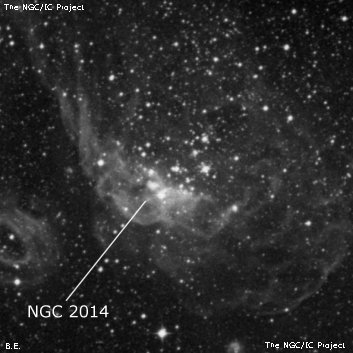
John Herschel discovered NGC 2014 = h2900 on 23 Dec 1834 and described the "chief *9 of a very irreg cluster, 4' long, 3' broad." On a second sweep he logged "a pretty L irreg cluster 7th class; chief *9m taken (at leaving the field); the rest are 10...15m." His position is accurate.
James Dunlop possibly discovered this cluster (D 217?) earlier on 3 Aug 1826 with his 9" reflector from Parramatta, NSW, and recorded "a rather well-defined nebula, 40" or 50" diameter. Dunlop observed this object 3 times and his position is 5' SSW of the cluster. Despite Dunlop's relatively good position, JH did not credit Dunlop with the discovery and Dunlop's description for D 217 implies a much smaller object, so I'm also hesitant about this identification.
600/800mm - 30" (11/5/10 - Coonabarabran, 264x): very bright, large cluster or star cloud (stellar association LH 76) with nebulosity, ~50 stars resolved in a 5' region (no distinct boundary on the north side), including many in a 2' string, elongated N-S. A mag 10 star (brightest in the cluster) is at the south end of this string. A portion of the cluster is immersed in nebulosity (Henize N57A), most prominently on the southeast side of the cluster. Irregular haze (roughly elongated SW-NE) extends out of the cluster for a couple of arc minutes on the east side, spreading south and north (part of a Superbubble). NGC 2014 forms an interesting contrast with emission nebula NGC 2020 5' ESE. The remarkable Seagull Nebula (NGC 2030, 2032, 2035) lies ~20' NE.
Notes by Steve Gottlieb